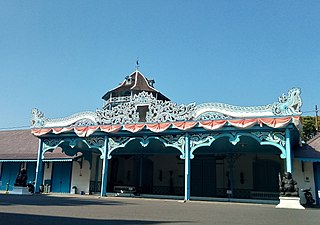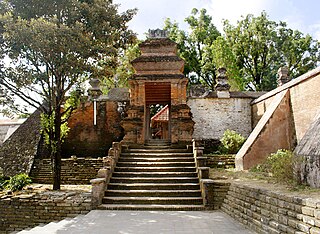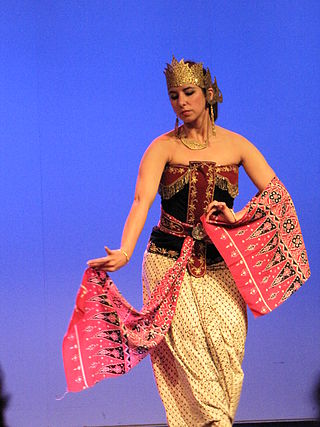
Gamelan is the traditional ensemble music of the Javanese, Sundanese, and Balinese peoples of Indonesia, made up predominantly of percussive instruments. The most common instruments used are metallophones and a set of hand-drums called kendang, which keep the beat. The kemanak, a banana-shaped idiophone, and the gangsa, another metallophone, are also commonly used gamelan instruments on Bali. Other notable instruments include xylophones, bamboo flutes, a bowed string instrument called a rebab, and a zither-like instrument called a siter, used in Javanese gamelan. Additionally, vocalists may be featured, being referred to as sindhen for females or gerong for males.

Central Java is a province of Indonesia, located in the middle of the island of Java. Its administrative capital is Semarang. It is bordered by West Java in the west, the Indian Ocean and the Special Region of Yogyakarta in the south, East Java in the east, and the Java Sea in the north. It has a total area of 33,750.37 km2, with a population of 36,516,035 at the 2020 Census making it the third-most populous province in both Java and Indonesia after West Java and East Java. The official population estimate in mid-2023 was 37,608,336 The province also includes a number of offshore islands, including the island of Nusakambangan in the south, and the Karimun Jawa Islands in the Java Sea.

The Javanese are an Austronesian ethnic group native to the central and eastern part of the Indonesian island of Java. With more than 100 million people, Javanese people are the largest ethnic group in both Indonesia and in Southeast Asia as a whole. Their native language is Javanese, it is the largest of the Austronesian languages in number of native speakers and also the largest regional language in Southeast Asia. As the largest ethnic group in the region, the Javanese have historically dominated the social, political, and cultural landscape of both Indonesia and Southeast Asia.

Surakarta, known colloquially as Solo, is a major city in Central Java, Indonesia. The 46.72 km2 (18.04 sq mi) city adjoins Karanganyar Regency and Boyolali Regency to the north, Karanganyar Regency and Sukoharjo Regency to the east and west, and Sukoharjo Regency to the south. On the eastern side of Solo lies Solo River. Its metropolitan area, consisting of Surakarta City and the surrounding six regencies, was home to 6,837,753 inhabitants according to the official estimates for mid 2023, 526,870 of whom reside in the city proper.

Kraton or keraton is a type of royal palace in Java, Indonesia. Its name is derived from the Javanese ka-ratu-an, meaning residence of the ratu, the traditional honorific title for a monarch. In Java, the palace of a prince is called pura or dalem, while the general word for palace is istana, which is identical to Malay.

The Solo River is the longest river in the Indonesian island of Java, it is approximately 600 km (370 mi) in length.

Kotagede is a city district (kemantren) and a historic neighborhood in Yogyakarta, Special Region of Yogyakarta, Indonesia. Kotagede contains the remains of the first capital of Mataram Sultanate, established in the 16th century. Some of the remains of the old Kotagede are remains of the palace, the royal cemetery, the royal mosque, and defensive walls and moats. Kotagede is well known internationally for its silver crafting.

Yogyakarta is the capital city of the Special Region of Yogyakarta in Indonesia, in the south-central part of the island of Java. As the only Indonesian royal city still ruled by a monarchy, Yogyakarta is regarded as an important centre for classical Javanese fine arts and culture such as ballet, batik textiles, drama, literature, music, poetry, silversmithing, visual arts, and wayang puppetry. Renowned as a centre of Indonesian education, Yogyakarta is home to a large student population and dozens of schools and universities, including Gadjah Mada University, the country's largest institute of higher education and one of its most prestigious.

Wayang wong, also known as wayang orang, is a type of classical Javanese and Balinese dance theatrical performance with themes taken from episodes of the Ramayāna or Mahabharāta. Performances are stylised, reflecting Javanese court culture:
Wayang wong dance drama in the central Javanese Kraton of Yogyakarta represents the epitome of Javanese aesthetic unity. It is total theatre involving dance, drama, music, visual arts, language, and literature. A highly cultured sense of formality permeates every aspect of its presentation.

Joglo is a type of traditional vernacular house of the Javanese people. The word joglo refers to the shape of the roof. In the highly hierarchical Javanese culture, the type of roof of a house reflects the social and economic status of the owners of the house; joglo houses are traditionally associated with Javanese aristocrats.

The architecture of Indonesia reflects the diversity of cultural, historical, and geographic influences that have shaped Indonesia as a whole. Invaders, colonizers, missionaries, merchants, and traders brought cultural changes that had a profound effect on building styles and techniques.

A pendhapa or pandhapa is a fundamental element of Javanese architecture unique in the southern central part of Java; a large pavilion-like structure built on columns. Either square or rectangular in plan, it is open on all sides and provides shelter from the sun and rain, but allows breeze and indirect light. The word pendhapa is cognate to the Sanskrit word mandapa ("hall").

Sekaten is a week-long Javanese traditional ceremony, festival, fair and pasar malam commemorating Mawlid, celebrated annually started on 5th day through the 12th day of Mulud month.

Javanese culture is the culture of the Javanese people. Javanese culture is centered in the provinces of Central Java, Yogyakarta and East Java in Indonesia. Due to various migrations, it can also be found in other parts of the world, such as Suriname, the broader Indonesian archipelago region, Cape Malay, Malaysia, Singapore, Netherlands and other countries. The migrants bring with them various aspects of Javanese cultures such as Gamelan music, traditional dances and art of Wayang kulit shadow play.

Javanese dance is the dances and art forms that were created and influenced by Javanese culture in Indonesia. Javanese dance movement is controlled, deliberate, and refined. Javanese art often displays finesse, and, at the same time, a serene composure which is elevated far above everything mundane. Javanese dance is usually associated with courtly, refined, and sophisticated culture of the Javanese kratons, such as the bedhaya and srimpi dance. However, in a wider sense, Javanese dance also includes the dances of Javanese commoners and villagers, such as ronggeng, tayub, reog, and jaran kepang.

Surakarta Sunanate is a Javanese monarchy centred in the city of Surakarta, in the province of Central Java, Indonesia.

Bintaran is a village in Wirogunan, Mergangsan, Yogyakarta, Indonesia. The area is known for its Dutch-Javanese architecture. It was formerly a Catholic settlement.

The Srimpi is a ritualised dance of Java, Indonesia, associated with the royal palaces of Yogyakarta and Surakarta. The srimpi dance is one of the classical dances of Central Java. Along with the bedhaya, srimpi epitomised the elegant character of the royal Javanese court, becoming a symbol of the ruler's power as well as the refinement of Javanese culture.

Javanese traditional house refers to the traditional vernacular houses of Javanese people in the island of Java, Indonesia.

The Pura Mangkunegaran is a palace complex in the city of Surakarta, Central Java, Indonesia. It is the official palace and residence of the Duke of Mangkunegara and his family. The palace complex is one of the centers of Javanese culture and contains a museum exhibiting royal artifacts of Mangkunegaran.






















